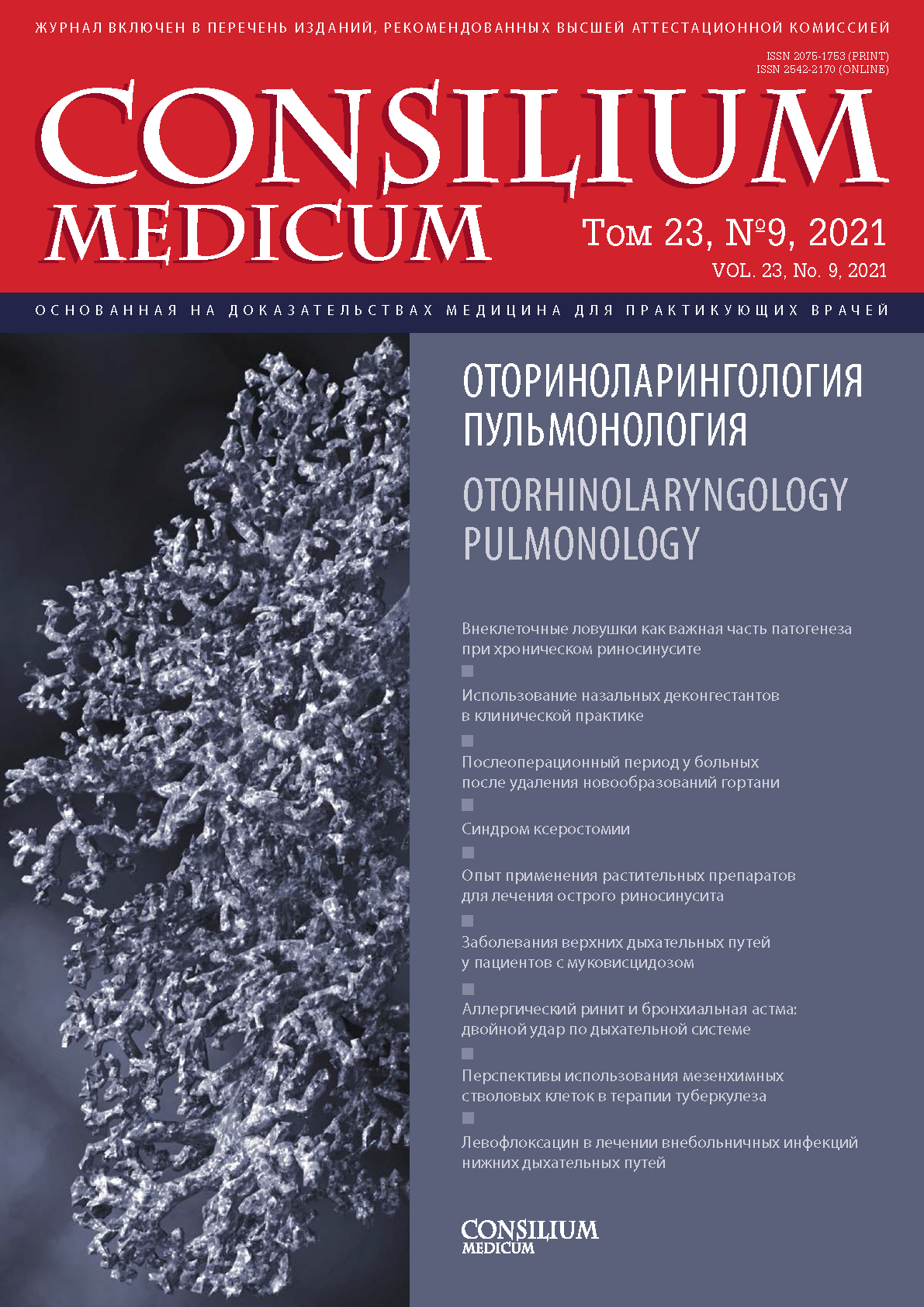The relevance of the situational use of nasal decongestants in modern clinical practice
- Authors: Morozova S.V.1, Keda L.A.1
-
Affiliations:
- Sechenov First Moscow State Medical University (Sechenov University)
- Issue: Vol 23, No 9 (2021)
- Pages: 400-405
- Section: Articles
- URL: https://journals.rcsi.science/2075-1753/article/view/95479
- DOI: https://doi.org/10.26442/20751753.2021.9.201029
- ID: 95479
Cite item
Full Text
Abstract
Nasal decongestants (ND) are representatives of the pharmacological group of а-adrenomimetics and are widely used in clinical practice. These drugs are successfully used as symptomatic therapy of acute rhinosinusitis (AR), as well as as part of the complex therapy of acute otitis during unloading therapy for the auditory tube. The use of ND is necessary before conducting an endoscopic examination of the nasal cavity, for a better assessment of the state of the ostiomeatal complex, the olfactory cleft, as well as differential diagnosis of various forms of rhinitis and dysosmia. ND are indispensable in the prevention of complications of AR, such as acute eustachiitis, exudative otitis media and acute otitis media. Also, these drugs are used in the prevention of the development of aerotitis and ear barotrauma. The most commonly used nasal medications of medium and long duration of action, such as xylometazoline and oxymetazoline. This article presents clinical studies demonstrating the high efficacy and safety of these drugs as part of the treatment of AR. It is shown that oxymetazoline and xylometazoline are well tolerated by patients with a minimum number of adverse events. Modern representatives of ND are such drugs as Otrivin express 0.05% with the aroma of menthol, the main active ingredient of which is oxymetazoline, Otrivin 0.1% Moisturizing formula and Otrivin 0.1% with menthol and eucalyptus, which includes xylometazoline as the main active ingredient. These drugs have confirmed their effectiveness and safety in a large number of clinical studies and can be recommended as local vasoconstrictors.
Full Text
##article.viewOnOriginalSite##About the authors
Svetlana V. Morozova
Sechenov First Moscow State Medical University (Sechenov University)
Author for correspondence.
Email: doctormorozova@mail.ru
д-р мед. наук, проф. каф. Moscow, Russia
Lina A. Keda
Sechenov First Moscow State Medical University (Sechenov University)
Email: linatoporkova94@gmail.com
аспирант каф. болезней уха, горла и носа Moscow, Russia
References
- Овчинников А.Ю., Мирошниченко Н.А., Рябинин В.А., Николаева Ю.О. Топические декон-гестанты длительного действия. Медицинский совет. 2020;16:134-8. DO 1:10.21518/2 079-701X-2020-16-134-138
- Морозова С.В., Топоркова Л.А. Применение назальных деконгестантов для коррекции дыхательной и обонятельной функции носа. Медицинский совет. 2019;8:60-5
- Corboz MR, Rivelli MA, Mingo GG, et al. Mechanism of decongestant activity of a2-adrenoceptor agonists. Pulm Pharmacol Ther. 2008;21(3):449-54. doi: 10.1016/j.pupt.2007.06.007
- Lacroix JS. Adrenergic and non-adrenergic mechanisms in sympathetic vascular control of the nasal mucosa. Acta Physiologica Scandinavica. 1989;581:1-63. Available at: https://www.semanticscholar.org/paper/Adrenergic-and-non-adrenergic-mechanisms-in- control-Lacroix/7f20 d9c17decf908dea2f45d34c68b13a8649b01. Accessed: 21.06.2021.
- Кривопалов А.А., Шамкина П.А. Топические деконгестанты в практике врача-оториноларинголога. Медицинский совет. 2020;21:84-9
- Грищенко Е.Б. Назальные деконгестанты в оториноларингологии. Медицинский совет. 2012;2:28-31. Режим доступа: https://cyberleninka.ru/article/nZnazalnye-dekongestanty-v-otorinolaringologii. Ссылка активна на 21.06.2021
- Варвянская А.В., Лопатин А.С. Топические назальные деконгестанты: сравнительная характеристика и обзор побочных эффектов. Российская ринология. 2015;23(4):50-6
- Fokkens WJ, Lund VJ, Hopkins C, et al. European Position Paper on Rhinosinusitis and Nasal Polyps 2020. Rhinology. 2020;29:1-464. doi: 10.4193/Rhin20.600
- Hummel T, Whitcroft KL, Andrews P, et al. EPOS. Supplement 26. Olfactory dysfunctions. Rhinology. 2016;56(1):1-30. doi: 10.4193/Rhin16.248
- Lindbaek M, Hjortdahl P, Johnsen UL. Use of symptoms, signs, and blood tests to diagnose acute sinus infections in primary care: comparison with computed tomography. Fam Med. 1996;28:183-8. Available at: https://www.ncbi.nlm.nih.gov/pubmed/8900550. Accessed: 21.06.2021.
- Острый синусит. Клинические рекомендации. М.: Национальная медицинская ассоциация оториноларингологов, 2016. Режим доступа: http://www.nmaoru.org/files/KR313%20 Ostryj%20sinusit.pdf. Ссылка активна на 21.06.2021
- Крюков А.И., Носуля Е.В., Ким И.А. Промывание носа: возможности и недостатки. Вестник оториноларингологии. 2018;83(6):76-80
- Adam P, Stiffman M, Blake RL Jr. A clinical trial of hypertonic saline nasal spray in subjects with the common cold or rhinosinusitis. Arch Fam Med. 1998;7(1):39-43. doi: 10.1001/archfami.7.1.39
- Kenealy T, Arroll B. Antibiotics for the common cold and acute purulent rhinitis. Cochrane Database Syst Rev. 2013;6:CD000247. doi: 10.1002/14651858.CD000247.pub3
- Reinecke S, Tschaikin M. Investigation of the effect of oxymetazoline on the duration of rhinitis. Results of a placebo-controlled double-blind study in patients with acute rhinitis. MMW Fortschr Med. 2005;147(Suppl. 3):113-8. Available at: https://pubmed.ncbi.nlm.nih.gov/16261947/Accessed: 21.06.2021 (in German).
- Druce HM, Ramsey DL, Karnati S, Carr AN. Topical nasal decongestant oxymetazoline (0.05%) provides relief of nasal symptoms for 12 hours. Rhinology. 2018;56(4):343-50. doi: 10.4193/Rhin17.150. PMID: 29785414
- Deckx L, De Sutter AI, Guo L, et al. Nasal decongestants in monotherapy for the common cold. Cochrane Database Syst Rev. 2016;10(10):CD009612. doi: 10.1002/14651858.CD009612.pub2
- Eccles R, Eriksson M, Garreffa S, Chen SC. The Nasal Decongestant Effect of Xylometazoline in the Common Cold. Am JRhinol. 2008;22(5):491-6. doi: 10.2500/ajr.2008.22.3202
- Морозова С.В., Топоркова Л.А. Применение назальных деконгестантов для коррекции дыхательной и обонятельной функции носа. Медицинский совет. 2019;8:60-5
- Крюков А.И., Ивойлов А.Ю., Пакина В.Р., и др. Алгоритм лечения детей с экссудативным средним отитом. Медицинский совет. 2013;7:52-3
- Свистушкин В.М., Морозова С.В., Волкова К.Б. Рациональное решение проблемы местного симптоматического лечения при остром среднем отите. Медицинский совет. 2018;8:42-5
- Косяков С.Я., Лопатин А.С. Современные принципы лечения острого среднего, затянувшегося и рецидивирующего острого среднего отита. РМЖ. 2002;10(20):1-11
- Отит средний острый. Клинические рекомендации. М.: Национальная медицинская ассоциация оториноларингологов, 2016. Режим доступа: http://www.nmaoru.org/files/KR314%20Ostryj%20 srednij%20otit.pdf. Ссылка активна на 21.06.2021
- Морозова С.В. Профилактика осложнений острого инфекционного ринита у детей. РМЖ. 2014;3:198-202. Режим доступа: https://rusmedreview.com/upload/iblock/22b/22b599ad e33f28b113274c05700ce4be.pdf. Ссылка активна на 21.06.2021
- Джафек Б.У., Старк Э.К. Секреты оториноларингологии. М.: БИНОМ; СПб.: Невский диалект, 2001; с. 97-105
- Лопатин А.С. Ринит. Патогенетические механизмы и принципы фармакотерапии. М.: Лит-тера, 2013; с. 26, 30, 214-6
- Овчинников Ю.М., Морозова С.В., Минор А.В. Нарушения обоняния (вопоросы теории, диагностики, лечения). М.: Изд-во ММА им. И.М. Сеченова, 1999; с. 46-54
- Овчинников Ю.М., Морозова С.В. Введение в отоневрологию. Учебное пособие. М.: Академия, 2006; с. 169-73
Supplementary files






